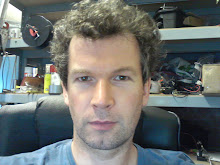Friday, November 26, 2010
end holes
These parts are too long to CNC drill the end holes, so I had to make a drilling guide first.
I used a 3mm milling cutter to pocket and profile the shape in the Delrin, then I used the pillar drill and put the aluminium part in the portable vice and held the Delrin guide onto the end of the part to do the drilling. I only used the guide to drill a small depth, then I drilled them through later.
Wednesday, November 3, 2010
Ungluing accident.
See my coolant delivery system in action in the video.
I had a problem with this part. The sawn piece was a tight fit in the pocket in the wood sub-table, so it didn't glue well, so it came unstuck soon after the start of machining. You can see the bent path left in the metal, in the video. I remachined the wood and chiselled the side of the pocket bigger and everything else went well, but there is a bit of a gouge out of the top of the circular post feature. Maybe it won't matter too much? The surface finish doesn't seem any different ( the one on the left of the picture is the most recent part ), despite lowering the feedrate to 50 mm/min instead of 100 mm/min. The tool looked slightly worn after the ungluing accident. It doesn't look much more worn after all the machining, so I think that 200 mm/min is better than 300 mm/min. Hopefully the next one I make won't have any mistakes in it.
I had a problem with this part. The sawn piece was a tight fit in the pocket in the wood sub-table, so it didn't glue well, so it came unstuck soon after the start of machining. You can see the bent path left in the metal, in the video. I remachined the wood and chiselled the side of the pocket bigger and everything else went well, but there is a bit of a gouge out of the top of the circular post feature. Maybe it won't matter too much? The surface finish doesn't seem any different ( the one on the left of the picture is the most recent part ), despite lowering the feedrate to 50 mm/min instead of 100 mm/min. The tool looked slightly worn after the ungluing accident. It doesn't look much more worn after all the machining, so I think that 200 mm/min is better than 300 mm/min. Hopefully the next one I make won't have any mistakes in it.
Part 0012, number 2
I have made another of these parts. This time I tried 3mm depth of cut. It was OK. Also I tried using climb milling for the finishing pass, instead of conventional milling. It isn't much different. Also I put the coolant guard back on, so I could pour the coolant on quicker. I made a mistake with the program for this one and there is a gouge, see the second picture. The tool is very battered. It has only made 2 parts. I noticed it was a bit damaged after the first part, but it is a lot more damaged now. I will try reducing the feedrate from 300 to 200. I will use a new cutter now. Also, the later roughing cuts are leaving the material up to 0.1 too thick. I can't explain this yet, so I will try it again to see if it happens again.
Tuesday, November 2, 2010
Part 0012 without holes

I made this part. No holes in the ends yet, though. The surface finish could be better. I am doing the finishing pass at a feedrate of 100. Maybe I should try 50?
Most of the time was spent doing the roughing, because I was only happy descending 1mm at a time with the 6mm tool. It took about 2 hours machining.
Monday, November 1, 2010
Part 0012, Roughing
The next thing is to calculate roughing toolpath. Here I have made the flat faces into sketches. I have had to draw some extra sketches. If the sketches touch each other, HeeksCNC joins them together nicely. I had to enter the z values correctly. Maybe one day I will automate all of this. There are 6 separate pocket operations.
Part 0012
I am going to make this part out of aluminium alloy.
The first thing is to saw out a piece of Delrin as the sub table and pocket a shape oversize, for the aluminium rectangle to fit in. I can specify to cut a sketch oversize by putting a negative value in the "material allowance" box. I am using a development version of HeeksCNC, which includes a commercial pocketing library written by Lou Lavery, that I am planning on reselling as an option for HeeksCNC when it is ready. I am trying to write a free version of pocketing, but it's not easy.
The first thing is to saw out a piece of Delrin as the sub table and pocket a shape oversize, for the aluminium rectangle to fit in. I can specify to cut a sketch oversize by putting a negative value in the "material allowance" box. I am using a development version of HeeksCNC, which includes a commercial pocketing library written by Lou Lavery, that I am planning on reselling as an option for HeeksCNC when it is ready. I am trying to write a free version of pocketing, but it's not easy.
Subscribe to:
Comments (Atom)













